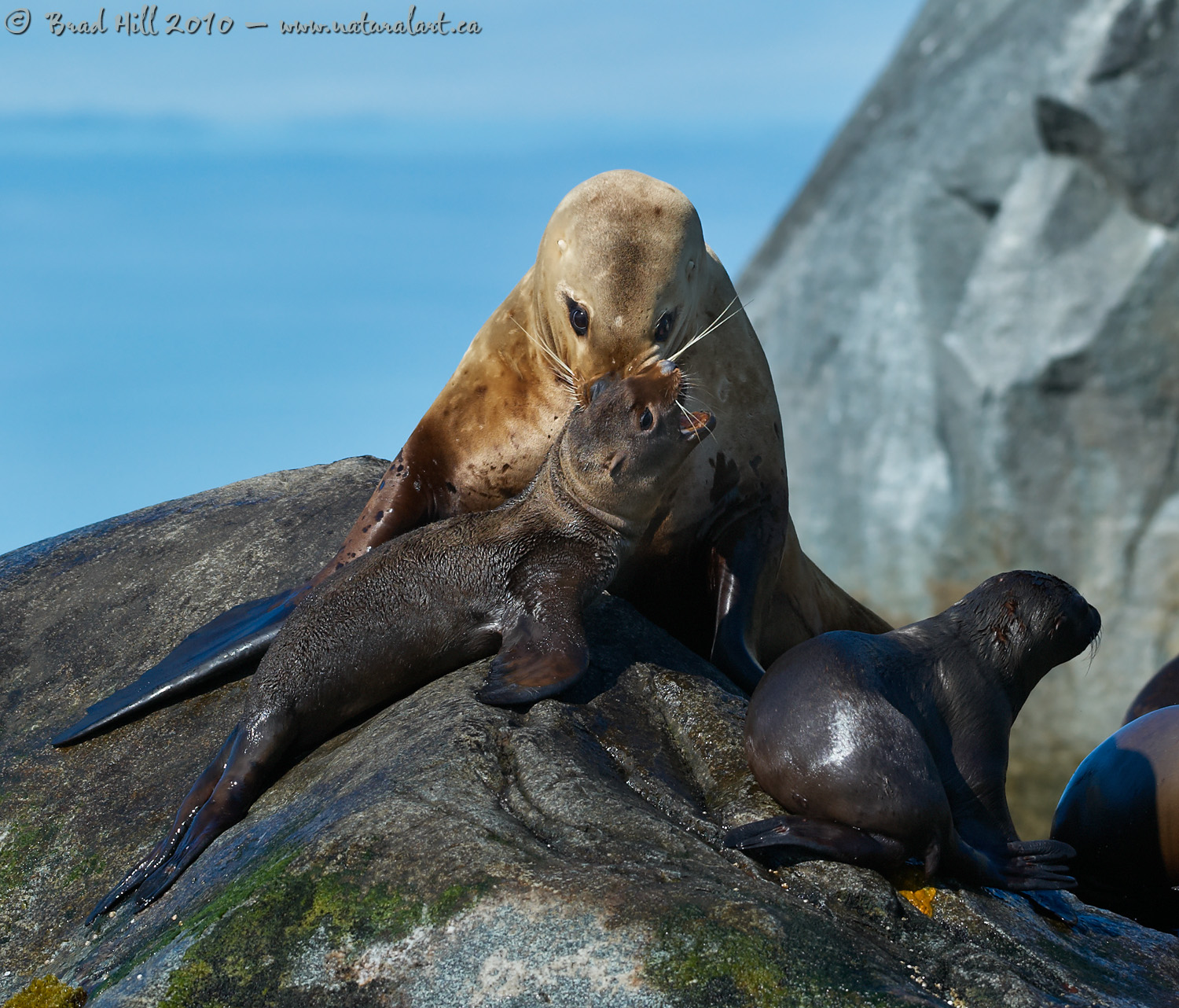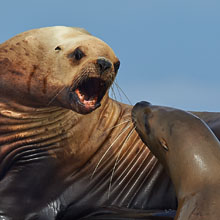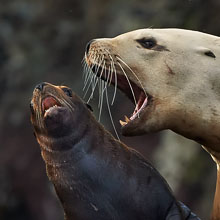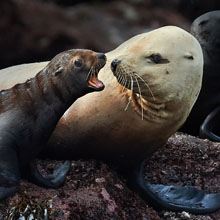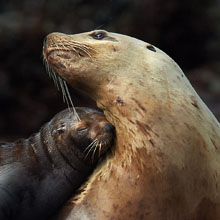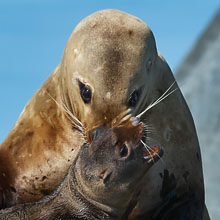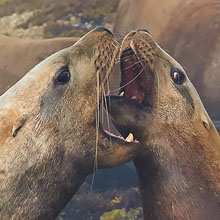Availability: Undetermined - Enquiries?
In the Field
Tough Love! Gwaii Haanas National Park, Haida Gwaii (Queen Charlotte Islands), BC, Canada. July 27, 2010.
This is the last shot in a sequence of images of a female Steller's Sea-Lion dragging one of its pups out of the ocean and onto a haul-out rock. In this shot the pup is loudly protesting what it apparently perceives as unduly harsh treatment and it's easy to imagine that Ma is holding on a little longer or tighter than it really needs to in order to teach junior a lesson about carelessly slipping into the sea!
Two comments about this image. First...to me this is one of those frustrating shots where ALMOST everything came together - kind of a "just missed" situation. Even though I shot this during a situation that could only be described as near bedlam (with gulls and cormorants flying in all directions and sea lions all around us) I noticed some compositional elements in this scene that worked really well for me. I'm referring to the combination converging leading lines formed by the foreground and background rocks that all end at the point of action. Seconds before I shot the image the scene was almost "clean" and without distracting elements, but at the last moment the 2nd cub to the right scampered into position and totally changed the scene to what you're seeing now. Bummer! I guess when photographing social, colonial species one has to accept the constraints! Oh, and by the way - YES, I know that between the clone tool and the "Content Aware Fill" feature of Photoshop CS5 I could easily rid the scene of the distracting 2nd pup, but that simply doesn't work for me philosophically.
My second comment pertains to leveling images. Pseudo-careful observers will likely notice that the head angle of the adult female sea-lion is slightly off-vertical, which visually implies I had the camera tilted a little when I shot the image (which wouldn't be surprising, given I shot this image while hand-holding a largish lens while bobbing in the ocean in an inflatable boat). However, VERY careful observers will notice that the faint cloud line in the distance IS level - implying that that shot is, in fact, level. This is a crop, and if I showed the full-frame image it would be even clearer that the image is level. But, this brings up an interesting conundrum: What's more important in an image - being perceived as level or actually BEING level (regardless of perception)? Normally, I try to make my captures as level as possible and am always comparing viewfinder reference points/lines to lines in the scene (horizons, vertical trees or poles, etc.), but - like everyone - occasionally I screw up. When I do, I normally opt for adjusting to a state of perceived level, as opposed to true level (unless, of course, they're the same). In this case, I experimented with making the female sea-lion's face absolutely vertical, and to my eye the tilted clouds looked WAY more unnatural than the slight tilt to the head (which really had no inherent reason for being absolutely vertical anyway).
One more little thing to lodge in your brain when shooting or processing your images! ;-)
ADDITIONAL NOTES:
1. This image - in all resolutions - is protected by copyright. I'm fine with personal uses of it (including use as desktop backgrounds or screensavers on your own computer), but unauthorized commercial use of the image is prohibited by law. Thanks in advance for respecting my copyright!
2. Like all wildlife photographs on this website, this image was captured following the strict ethical guidelines described in The Wildlife FIRST! Principles of Photographer Conduct. I encourage all wildlife photographers to always put the welfare of their subjects above the value of their photographs.
Behind the Camera
Tough Love! Gwaii Haanas National Park, Haida Gwaii (Queen Charlotte Islands), BC, Canada. July 27, 2010.
Digital Capture; RAW 14-bit format; ISO 400.
Nikon D3s with Nikkor 200-400mm f4 VR lens @ 210mm - handheld. VR on and set to "Active" mode.
1/1250s @ f6.3; -0.67 stop compensation from matrix-metered exposure setting of camera.
At the Computer
Tough Love! Gwaii Haanas National Park, Haida Gwaii (Queen Charlotte Islands), BC, Canada. July 27, 2010.
RAW Conversion to 16-bit TIFF, including first-pass/capture sharpening using Phase One's Capture One Pro 5. Three RAW conversions at different exposure settings. Exposure settings at -1.0 stops compensation (to retrieve highlight detail in reflected light on rocks and sea-lions) through to +0.25 stops to extract shadow detail on left side of adult female sea-lion (right side of image).
Further digital corrections on 16-bit TIFF file using Adobe's Photoshop CS5 and Light Craft's LightZone. Photoshop adjustments included compositing and masking of 3 exposure versions, selective saturation of colours and selective sharpening for web output. Final tonemapping and tweaking performed with LightZone use the (tonemapper/re-light tool).
Conservation
Tough Love! Gwaii Haanas National Park, Haida Gwaii (Queen Charlotte Islands), BC, Canada. July 27, 2010.
Ten percent of the revenue generated by this image will be donated to Raincoast*.
Species Status in Canada**: Special Concern (November 2003) - protected in Canada since 1970.
The Steller's Sea-Lion (Eumetopias jubatus) is the largest of the sea-lions, and males can weigh up to a ton (females are considerably smaller and rarely weigh over 600 lb). Males compete among themselves for females, and successful males end up breeding with several females within their harem.
From the early 1900's through to the 1970's huge numbers of Steller's Sea-Lions were culled for their fur and to remove a competitor (for humans) for salmon. During that time approximately 55,000 sea lions were killed and the breeding population of BC was lowered to about 4,000 animals. Since the Steller Sea Lion first received protection in 1970 the population in the coastal waters of BC has grown to between 18,000 to 19,700 animals (7,600 or so of these are of breeding age).
*The Raincoast Conservation Society (and Foundation) is an effective and efficient organization that has been fighting for protection of this unique habitat. If you are looking for a meaningful way to contribute to the conservation of this amazing ecosystem, Raincoast will provide maximal "bang" for your conservation dollars.
**as determined by COSEWIC: The Committee on the Status of Endangered Wildlife in Canada












